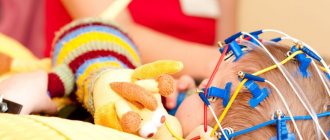Epilepsy is a chronic neurological disease characterized by the occurrence of convulsive and non-convulsive seizures in children and adults. Doctors distinguish several forms of pathology depending on the prevalence of clinical manifestations. Generalized epilepsy is associated with severe seizures affecting the entire body, and in the partial form, muscle contractions are localized to a specific part of the body.
To identify pathology, electroencephalography, MRI and other diagnostic procedures are used. Treatment of primary and symptomatic partial epilepsy is based on the use of anticonvulsant drugs.
Partial epilepsy: what is it?
The most common type of this epilepsy is a convulsive reaction of the body to pathological nerve impulses from a localized focus of the brain. Partial epilepsies are caused by structural changes in part of the cerebral cortex. They are recorded in 80% of epileptic seizures in adults and 60% in children.
In accordance with the localization of the pathology, their manifestations are various types of motor, sensory, autonomic and mental disorders.
During a simple seizure, the epileptic remains conscious, but is unable to control the movements of certain parts of the body or experiences various unusual sensations. During complex paroxysms, a complete or partial loss of consciousness occurs, the patient becomes non-communicative and does not understand the phenomena occurring in his body.
During epileptic seizures, uncontrolled movements are observed, and purposeful actions that have been started often continue. Simple and complex partial changes can result in generalized seizures.
Epileptic changes are short-lived, on average their duration varies from thirty seconds to three minutes. Subsequently, the patient feels mental confusion and drowsiness, and after losing consciousness he cannot remember what happened. During the long chronic course of the disease, mental disorders occur, repeated seizures result in a decrease in intellectual thinking, and changes in the patient’s personal characteristics.
Consequences of the disease
Despite the favorable prognosis with complex treatment of partial epilepsy, the disease can cause acute and chronic complications. Acute changes in the psyche are manifested by the emergence of various types of dysphoria in the patient - from feelings of anxiety and melancholy to epileptic psychosis.
Chronic consequences for the patient’s mental sphere are as follows:
- the emergence of intrusiveness towards others;
- pronounced egocentrism with a gradual narrowing of the range of interests;
- pedantry and pathological thoroughness, which often prevent patients from engaging in any activity, including professional activities.
The possibility of a partial seizure becoming a generalized one causes an increased risk of status epilepticus - loss of consciousness and severe convulsions, without “light” intervals between them. If left untreated, status epilepticus can cause severe organic and functional damage to brain structures.
Types of partial seizures
Imaging of the clinical manifestation is classified according to the location of the pathology in focal seizures and secondary generalized seizures. Epilepsy attacks are structured depending on which affected area of the cerebral cortex they are caused by.
The following types of manifestations of the disease are distinguished:
- Temporal - 44%.
- Frontal - 24%.
- Multifocal - 21%.
- Symptomatic occipital - 10%.
- Parietal - 1%.
If the frontal lobe of the brain is the source of pathological epileptic paroxysm, then attacks can be divided into the following types:
- motor, characterized by clonic convulsions of the arms and legs, somatosensory aura, the development of an attack and its transition to secondary generalization is possible;
- frontopolar (anterior), accompanied by an altered sense of time, dips and influxes of thoughts;
- cingulate, accompanied by affective, hypermotor attacks, ipsilateral blinking, facial hyperemia;
- dorsolateral, characterized by signs of eye adversion, speech arrest, bilateral proximal tonic seizures, secondary generalization;
- orbitofrontal, accompanied by vegetative-visceral attacks (cardiovascular, epigastric, respiratory), psychomotor in the form of automatism of gestures, pharyngeal-oral automatisms, hypersalivation;
- opercular, represented by oroalimentary automatisms in the form of coughing, smacking, swallowing, chewing, sucking movements, twitching of the eye muscles, speech disorders;
- supplementary motor areas, manifested by simple partial seizures, archaic movements, motor, speech or sensory, mainly occurring at night;
- rapidly progressing Kozhevnikov syndrome, difficult to cure.
Right-sided and left-sided temporal lobe epilepsy differ in characteristics during, between, and after seizures.
Temporal lobe epilepsy comes in two forms:
- Amygdalo-hippocampal (paliocortical, medio-basal), manifested by sensory, motor, vegetative-visceral effects, mental dysfunction, automatism, loss of consciousness and a state of amnesia during complex attacks.
- Lateral (neocortical), characterized by dizziness, speech impairment, and the appearance of auditory or visual hallucinations.
Parietal epilepsy is represented by:
- posterior parietal seizures, characterized by immobility, visual defects and impaired awareness;
- anterior parietal attacks, characterized by sensory phenomena;
- lower parietal attacks, manifested by disorientation, discomfort in the abdomen, dizziness;
- paracentral seizures, characteristic pathological sensations in the genital area, rotational movements and postural changes.
Depending on the causes of the disease, pathological types of epilepsy differ:
- Idiopathic - congenital, arising due to genetic predisposition and neurological or mental pathologies, congenital abnormalities of the brain.
- Symptomatic - secondary, complicated by a primary brain disease.
- Cryptogenic - paroxysms of unknown etiology.
Dysmnestic seizures
This course is characterized by the development of paroxysms:
- “ Already seen ” - in this case, it seems to the patient that he has already seen it, it is familiar to him, that is, a repetition of what has already been seen. In such cases, the situation in the past seems to be repeated; it seems that the surroundings are exactly repeated, as if they were captured in a photograph in the past and transferred to the present. In this case, it is possible to reflect visual and auditory impressions, aromas, thoughts, actions and deeds.
- “ Already heard ” - there is a duplication of feelings that are close to the patient’s personality, that is, it is not events that are repeated, but a mood that, under the influence of the lived moment, becomes consonant with the present.
- “ Already experienced ” - the words of songs or conversations that he hears or takes part in seem familiar to the patient. At the same time, patients strive to restore in their memory a “familiar moment” from life, sounds or words. If they fail to remember, they are inclined to think that they saw it in a dream. Such seizures are distinguished by their paroxysmal nature, patterned nature and precise reproducibility, so they are thoroughly similar to each other. During the seizure, the patient seems to find himself in another dimension, so they freeze, hear the conversation, but do not understand its meaning, their gaze is motionless and fixed on one point. At the end of the attack, they feel unwell and drowsy.
Reasons for the development of the disease
Pathological processes occurring in the brain provoke the appearance of epileptic seizures. Several neurons generate pathological impulses of low amplitude and high frequency.
There is a disruption in the membrane permeability of brain cells, which desynchronizes the work of cells near negative neurons.
The pathological rhythm of a group of neurons creates a focal epileptic activity in the damaged part of the human brain. As a result of some exogenous factors, neural impulses spread and cover neighboring tissues, manifesting themselves in an epileptic seizure. The causes of epileptic paroxysms can be perinatal and postnatal factors.
Perinatal causes are called:
- intrauterine infection;
- hypoxia;
- ectomesodermal and cortical dysplasia;
- birth trauma.
Partial epilepsy develops with the following postnatal organic lesions of the cerebral hemispheres:
- cysts;
- acute circulatory disorders;
- bruises;
- tumors.
Among the reasons for the formation of pathological foci of the medulla are:
- infectious inflammatory diseases: abscess, encephalitis, meningitis;
- viral, bacterial, protozoal infection;
- post-stroke condition;
- dysgenesis, atriovenous malformation;
- rheumatic diseases of the nervous system;
- presence of multiple sclerosis;
- foci of gliosis;
- alcohol, amphetamine, cocaine, ephedrine and other drug addictions;
- long-term effects of antipsychotics, antidepressants, bronchodilators;
- presence of antiphospholipid syndromes;
- neurofibromatosis, tuberculous sclerosis;
- poisoning with poisons (lead, mercury, gasoline, barbiturates);
- infections: typhoid and malaria;
- endogenous intoxication due to liver and kidney pathologies;
- hyperglycemia.
What it is?
Partial seizures are symptoms that can be both generalized and invisible to others, blackouts, short-term and quickly disappearing.
A pathology called epilepsy, formerly falling sickness, is characteristic not only of humans, but of animals, including cats, dogs and mice. A characteristic feature is a tendency to the sudden onset of a convulsive syndrome - an epileptic attack.
The mechanism of development of the underlying pathology is associated with the formation of many foci of uncontrolled excitation in certain areas of the brain.
In this case, the following types of violations appear from the following sides:
- autonomic nervous system;
- physical activity;
- skin sensitivity;
- thinking;
- consciousness.
Most often, the first signs are found in children, since at a young age the body is biologically characterized by high convulsive activity. At this time, the brain is extremely easily excited and reacts in a generalized manner to irritating factors.
The frequency and prevalence of epilepsy among the population is about 1%. Partial seizures are very complex pathologies. The main factor why signs of another attack suddenly appear is convulsive readiness. In this state, the body, under the influence of any provoking factor, will immediately respond with the occurrence of seizures.
The duration of an epileptic attack can vary widely and on average ranges from 5 seconds to 10 minutes. Despite its relative rarity, the main danger in the active phase of the disease is associated with the risk of sudden death syndrome in epilepsy - SUDEP. The prevalence of the disease among people reaches 10 cases per 1000 people.
According to statistics, with this result, the victims had the following characteristics:
| Connection | Factor |
| With the patient |
|
| With attacks |
|
| With treatment |
|
Taking into account these factors, the approach to treatment should be comprehensive and carefully thought out with the prescription of clear, correctly calculated doses of traditional drugs for antiepileptic therapy.
Symptoms
The occurrence of epileptic seizures can occur at any age, but most often it occurs in the preschool period and in primary school age. Focal seizures can last several minutes, sometimes ending in a generalized seizure. Patients experience convulsions, spasms, numbness of the limbs, speech impairment and hallucinations. Symptoms depend on the location of the pathology.
Symptoms of frontal lobe epilepsy
Clinical contractions of the facial muscles and limbs cover one half of the body. The head and eyes turn in one direction. The phenomena of shouting, chewing, smacking, drooling, and rolling the eyes often begin.
Arms and legs tense and stretch along the body. Phenomena of auditory and visual hallucinations are often observed. Paroxysms are distinguished by motor automatisms or autonomic disorders.
Symptoms of temporal lobe epilepsy
Temporal lobe epilepsy is characterized by an abundance of olfactory, visual, auditory and gustatory hallucinations. For example, objects lose their usual size, the patient feels a strong smell of paint, gasoline or burnt rubber, and an auditory hallucination appears in the form of noise and hum, and other unusual sounds.
Many experience a feeling of déjà vu, increased heart rate, abdominal pain, nausea, fever and severe sweating. The patient may experience euphoria, dysphoria, or other obsessive states.
Symptoms of parietal epilepsies
The symptoms of this type of seizure vary depending on the location of the epileptic focus. With lower parietal paroxysms, disorientation in space and dizziness appear. Anterior parietal seizures are accompanied by a feeling of numbness and paralysis of the limbs. A posterior parietal seizure is characterized by impaired awareness, freezing, and a fixed gaze.
Symptoms of occipital epilepsies
Occipital seizures are characterized by visual hallucinations such as colored spots, circles and lines, blinking, and eye socket twitching.
Symptoms of Kozhevnikov syndrome
This syndrome affects half of the patient’s body with convulsions; attacks often end in paralysis of the arms and legs. Patients become aggressive, often fall into depression, and their intellectual level decreases. The syndrome is complicated by phobias and destruction of personal qualities.
Types of attacks and their symptoms
Partial epilepsy in each patient manifests itself in purely individual attacks. But there is an accepted classification of their main types. In simple partial attacks, the patient’s consciousness is retained completely or partially. This condition has different forms of manifestation:
- one can observe not very intense contractions of the muscles of the legs, arms, facial muscles, the patient feels numbness, tingling, so-called “goosebumps” on his skin;
- the patient turns his eyes, head, and sometimes his entire body in a certain direction;
- there is drooling;
- the patient performs chewing movements and grimaces;
- the speech process stops;
- pain appears in the epigastric area, heartburn, heaviness, peristalsis increases, flatulence appears;
- hallucinations may be observed: gustatory, olfactory, visual.
About a third of patients experience complex partial seizures, in which the person loses consciousness.
Such patients are often fully aware of what is happening, but are not able to speak or answer the questions posed. Often after another attack the patient experiences amnesia. He forgets everything that happened.
It often happens that epilepsy begins with a partial form, and then both hemispheres of the brain suffer. This becomes the cause of the development of a secondary seizure, generalized. It often makes itself felt in the form of severe cramps.
Symptoms of complex partial seizures:
- The patient develops severe anxiety and fear of death .
- He concentrates on the events that happened or the words he heard , and experiences strong feelings because of them.
- The patient begins to perceive a completely familiar environment as unfamiliar to him. Or maybe, on the contrary, you are haunted by a feeling of “déjà vu” .
- The patient perceives what is happening as something unreal . He may perceive himself as the hero of a book, a movie he has seen, or even observes himself as if from the outside.
- Automatisms . These are certain obsessive movements. What specific movement a patient will experience depends on which area of his brain is affected.
- In the short periods between seizures, a person at the initial stage of development of partial epilepsy feels quite normal. But over time, symptoms of brain hypoxia or underlying pathology become more and more apparent . Headaches, sclerosis appear, personality changes, dementia (dementia) is observed.
Let us consider the manifestation of each type of disease in more detail.
Diagnostics
If signs of impaired brain activity or epileptic seizures appear, you should urgently seek the advice of a neurologist or epileptologist. The doctor will conduct an examination, collect medical history data and prescribe a full examination to determine the type and characteristics of this epilepsy. Information received by doctors from the patient’s relatives is of great importance for the correct diagnosis.
The description should include:
- features of the state before the attack (excitement, complaints of feeling unwell);
- duration of the attack (preferably as accurate as possible);
- characteristics of the onset of the attack (gradual or sudden);
- description of the passage of the attack (reaction of speech, eyes, limbs, convulsions, loss of consciousness);
- examples of assistance provided;
- age of the patient at the time of the first seizure.
Diagnosis is based on the etiology of the disease, examination of the clinical picture of attacks, indications of neuroradiological analysis, as well as the mental and neurological state of the patient. Pathologies of neuronal activity are detected by instrumental and laboratory examinations.
Instrumental examination methods are:
- electroencephalography;
- CT scan;
- Magnetic resonance imaging;
- X-ray examination of the skull;
- ECG study (to exclude the cardiogenic origin of seizures).
Laboratory examination methods include:
- biochemical analysis of blood and urine;
- cerebrospinal fluid analysis;
- chromosomal karyotype study;
- DNA analysis to detect the fragile chromosome.
Treatment of the disease
Partial seizures are a complex of symptoms, the causes of which can be dealt with by neurologists or psychiatrists. If possible, it is advisable to undergo examinations and discuss the possibility of certain treatment methods with a more specialized specialist - an epileptologist.
In addition to the basic set of medical knowledge in the specializations of neurology and psychiatry, such a doctor receives additional knowledge in several areas:
- pharmacological properties and characteristics of drugs against epilepsy;
- mastering techniques for assessing the structure, biochemistry and functions of the brain;
- electrical physiology of all formations in the head;
- genetic characteristics of individuals;
- paroxysmal spectrum deviations;
- ways to rehabilitate patients.
This level of training allows epileptologists to take a comprehensive and multifaceted approach to the study of each individual case when identifying the described disease. In addition to general specialists, in cases involving children, you can contact a doctor who specializes in their treatment directly.
Such a doctor additionally studies techniques that can be used at a young age to completely get rid of the recurrence of unwanted symptoms. With persistent treatment with all prescribed drugs, the chance of absolute recovery increases.
Partial seizures that are dangerous to humans are only symptoms. This means that, along with complete relief of attacks, it is necessary to eliminate the immediate cause of their occurrence. The modern level of medicine in the vast majority of cases makes it possible to return a person to a full life without the risk of relapse of seizure conditions.
Treatment
Treatment of epilepsy achieves complete or partial cessation of epileptic seizures and minimization of side complications. Drug therapy is the main treatment method for epileptics. Individually selected drugs take into account the type of epilepsy, where the pathological focus is located in the brain, and the characteristics of the attacks.
The correct selection of medications affects the effectiveness of therapeutic effects and reducing the frequency of attacks, maintaining a normal lifestyle for the patient and the onset of stable remission. Conservative therapy controls up to 70% of partial changes.
The first choice antiepileptic drug is carbamazepine .
Additional drugs: Clonazepam, Valproate, Clobazam and benzodiazepines .
Anticonvulsant drugs are widely used: Finlepsin, Tegretol, Zeptol, Actineural, Diphenin, Tiagabine, Ethosuximide, Lamotrigine .
Long-acting medications are preferred because they can be taken once a day. Medications are discontinued by gradually reducing the dosage in the absence of attacks for the last 5 years.
If the use of anticonvulsants does not show positive dynamics, neurosurgery may help the patient. Surgical treatment methods include removal of a tumor or hematoma, lobectomy (removal of pathological areas of the brain), insertion of a subcutaneous vagus nerve stimulator, callesotomy (consisting in dissection of the cerebral hemispheres). Recent advances in surgical techniques have proven that epilepsy is not incurable.
Aphasic
They first appear in childhood, starting at the age of 3, and are characterized by the gradual development of aphasia - the loss of already acquired speech skills. At first, this sensorimotor disorder looks like a lack of reaction on the part of the child when addressed to him. Then, over the course of several months, the pathological signs increase: the answers become monosyllabic, then speech disappears completely.
At this stage, aphasia is joined by a disorder of auditory perception - agnosia, which contributes to the formulation of diagnoses such as autism or hearing loss. After a few weeks, epileptic seizures themselves appear, most often generalized with a tonic-clonic type of seizures (alternating prolonged spasms and twitchings).
In parallel, in most cases there is an increase in aggressiveness, irritability, and hyperactivity.
Prevention and prognosis
Preventive measures for epilepsy consist of systematically keeping the patient at the dispensary and conducting clinical examinations every 6 months.
Such an examination includes:
- electroencephalograms;
- magnetic resonance imaging of the brain;
- appointments with neurologists and psychiatrists;
- laboratory diagnostics (blood and urine tests).
Prevention of seizures of partial epilepsy is directly related to the healthy functioning of the epileptic.
An urgent need is to stop smoking and drinking alcohol. It is necessary to exclude coffee and strong tea from the diet. Patients must adhere to normal sleep and wakefulness and diet. Epileptics will have to avoid negative factors (extreme sports, climbing to heights, etc.).
Recovery prognosis differs for different types of disease and individual characteristics of the patient. Most patients achieve long-term remission and a decrease in the number of seizures. Much depends on timely treatment and compliance with doctors’ recommendations. About a third of cases of epilepsy are not amenable to medication and are cured by neurosurgery.
Prevention
There is no specific prevention. Doctors highlight a number of general recommendations aimed at improving the quality of life and health:
- Normalize your diet by excluding fatty, smoked, and salty foods. You should increase your consumption of vegetables, fruits, nuts and lean meats.
- Increase physical activity by visiting the pool, gym, cycling, running, etc.
- Eliminate bad habits.
- If you have somatic and neurological diseases, seek medical help in a timely manner and follow the prescription of your doctor.
Partial epilepsy, unlike the generalized form, has a favorable prognosis. Detection of the disease after the first attack and complex therapy, including medications, allows you to control the course of the disease and prevent repeated seizures. Patients should under no circumstances self-medicate, as this is fraught with the development of generalized seizures and complications.
You may also be interested in:
Classification of attacks
There are more than thirty types of epileptic seizures, which vary in nature. There are two main types of seizures:
- Partial (focal or patchy) occur in a limited part of the brain.
- Generalized, or general, covers both hemispheres.
Partial seizures include:
- Simple - consciousness never turns off, accompanied by unpleasant sensations in one part of the body.
- Complex – expressed by motor manifestations, they are accompanied by a change in consciousness.
The following subspecies belong to the generalized ones:
- Tonic-clonic - manifested by loss of consciousness, tonic convulsions, twitching of the torso and limbs, often biting the tongue, urinary incontinence, sometimes holding the breath, but suffocation does not occur.
- Absence seizures - consciousness instantly turns off for up to 30 seconds, movement suddenly stops, there is no reaction to external stimuli, eyes may roll back, eyelids and facial muscles twitch, then there are no convulsions. The attack occurs up to a hundred times a day. More common in teenagers and children.
- Myoclonic - seizures last several seconds and are manifested by jerky muscle twitches.
- Atonic or akinetic - a sharp loss of tone of the entire body or a separate part of it. In the first case, the person falls, in the second, the head or lower jaw hangs.
All types of partial and generalized seizures can occur unexpectedly and at any time, so patients always remember this.
Forms of the disease
Simple or complex seizures may occur. In simple cases, convulsions are observed in certain parts of the body. There is a rhythmic contraction of the muscles, with foam or copious salivation. The attack lasts less than 5 minutes.
If sensory attacks occur, visual, auditory or taste hallucinations are observed. Numbness of a certain part of the body appears.
During vegetative attacks, severe sweating and tachycardia occur.
The patient experiences severe fear. Later depression and insomnia develop.
For complex attacks, consciousness is impaired. There is a stupor, the person suddenly freezes, fixing his gaze on one point. In this case, a loss of reality occurs, movements become the same, and most often the person forgets about the attack. This attack lasts 1-2 minutes.
Frontal
It is characterized by the location of lesions in the frontal part of the brain. The disease can appear at any age. This form is characterized by frequent attacks lasting up to 1 minute.
There are no prerequisites for their appearance. They can start and end suddenly. A person often experiences nocturnal attacks, which are accompanied by somnambulism or parasomnia.
Temporal
The lesion is observed in the temporal region of the brain. This form of the disease can be triggered by head injuries or inflammatory processes in the brain.
The patient experiences a change in consciousness, he makes meaningless movements, and there is a loss of motivation.
Temporal lobe epilepsy pathology subsequently leads to autonomic disorders and social inability.
The disease is chronic and progresses over time.
Parietal
It is characterized by acute attacks with somatic manifestations, dizziness, complex visual hallucinations, and impaired body perception.
The attack lasts no more than 2 minutes, but can be repeated several times a day.
The highest peak frequency of repetitions is achieved during the daytime. This form of the disease can manifest itself at any age.
Occipital
It is typical for children from 2 to 4 years old. With properly selected therapy, the disease has a favorable prognosis.
The disease is benign in nature and is expressed in visual disturbances. Children complain about spots before their eyes and the appearance of lightning. Rotation of the eyeballs and head tremor are also observed.
Multifocal
This type of disease forms so-called mirror lesions. The first lesion that forms leads to the appearance of disturbances and pathological excitation in the same location, but in the neighboring hemisphere.
Already in infancy, the first manifestations of this form of the disease are observed. The child’s mental development is disrupted and pathological changes are observed in the structure of internal organs.
Multifocal epilepsy is not amenable to drug therapy, as it is characterized by drug resistance. If the child has clear visualization of the lesion, surgical treatment is performed.











